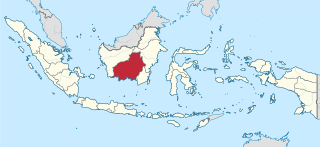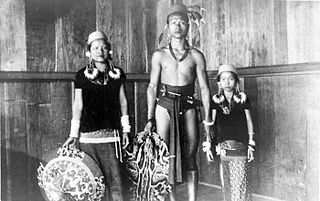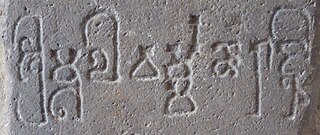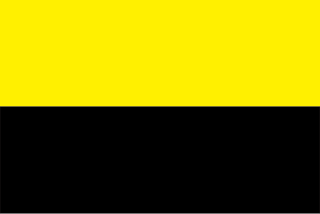
Borneo ; Indonesian: Kalimantan) is the third-largest island in the world and the largest in Asia. At the geographic centre of Maritime Southeast Asia, in relation to major Indonesian islands, it is located north of Java, west of Sulawesi, and east of Sumatra.

The Dayak or Dyak or Dayuh are one of the native groups of Borneo. It is a loose term for over 200 riverine and hill-dwelling ethnic groups, located principally in the central and southern interior of Borneo, each with its own dialect, customs, laws, territory, and culture, although common distinguishing traits are readily identifiable. Dayak languages are categorised as part of the Austronesian languages. The Dayak were animist in belief; however, since the 19th century there has been mass conversion to Christianity as well as Islam due to the spreading of Abrahamic religions.

The Indonesia–Malaysia confrontation or Borneo confrontation was an armed conflict from 1963 to 1966 that stemmed from Indonesia's opposition to the creation of the Federation of Malaysia. After Indonesian president Sukarno was deposed in 1966, the dispute ended peacefully and the nation of Malaysia was formed.

West Kalimantan is a province of Indonesia. It is one of five Indonesian provinces comprising Kalimantan, the Indonesian part of the island of Borneo. Its capital city is Pontianak. The province has an area of 147,307 km2, and had a population of 4,395,983 at the 2010 Census and 5,414,390 at the 2020 Census. Ethnic groups include the Dayak, Malay, Chinese, Javanese, Bugis, and Madurese. The borders of West Kalimantan roughly trace the mountain ranges surrounding the vast watershed of the Kapuas River, which drains most of the province. The province shares land borders with Central Kalimantan to the southeast, East Kalimantan to the east, and the Malaysian territory of Sarawak to the north.

South Kalimantan is a province of Indonesia. It is the smallest province in Kalimantan, the Indonesian territory of Borneo. The provincial capital was Banjarmasin until 15 February 2022 when it was legally moved to Banjarbaru. The population of South Kalimantan was recorded at just over 3.625 million people at the 2010 Census, and at 4.07 million at the 2020 Census. One of the five Indonesian provinces in Kalimantan, it is bordered by the Makassar Strait in the east, Central Kalimantan in the west and north, the Java Sea in the south, and East Kalimantan in the north. The province also includes the island of Laut, located off the eastern coast of Kalimantan. The province is divided into 11 regencies and 2 cities. South Kalimantan is the traditional homeland of the Banjar people, although some parts of East Kalimantan and Central Kalimantan are also included in this criteria. Nevertheless, South Kalimantan, especially the former capital city Banjarmasin has always been the cultural capital of Banjarese culture. Many Banjarese have migrated to other parts of Indonesia, as well as neighbouring countries such as Singapore and Malaysia. In addition, other ethnic groups also inhabit the province, such as several groups of the Dayaks, who mostly live in the interior part of the province, as well as the Javanese, who mostly migrated from Java due to the Transmigration program which dated from the Dutch colonial era.

Central Kalimantan is a province of Indonesia. It is one of five provinces in Kalimantan, the Indonesian part of Borneo. Its provincial capital is Palangka Raya and in 2010 its population was over 2.2 million, while the 2015 Intermediate Census showed a rise to 2.49 million and the 2020 Census showed a total of 2.67 million.

East Kalimantan is a province of Indonesia. Its territory comprises the eastern portion of Borneo. It had a population of about 3.03 million at the 2010 Census, 3.42 million at the 2015 Census, and 3.766 million at the 2020 census. Its capital is the city of Samarinda.

The North Kalimantan Communist Party was a communist political party based in the Malaysian state of Sarawak in northern Borneo. It was formally founded on 30 March 1971. Before that, the group had been operating under the name Sarawak People's Guerrillas. The chairman of the NKCP was Wen Min Chyuan and the party enjoyed close links with the People's Republic of China. The NKCP's membership was predominantly ethnically Chinese. The two military formations of the NKCP were the Sarawak People's Guerilla Force (SPGF) or Pasukan Gerilya Rakyat Sarawak (PGRS), and the North Kalimantan People's Army (NKPA) or the Pasukan Rakyat Kalimantan Utara (PARAKU). The NKCP participated in the Sarawak Communist Insurgency (1962–1990). On 17 October 1990, the North Kalimantan Communist Party signed a peace agreement with the Sarawak state government, formally ending the Sarawak Communist Insurgency.

Being an indigenous tribe in Borneo, the Kayan people are similar to their neighbours, the Kenyah tribe, with which they are grouped together with the Bahau people under the Apo Kayan people group. The Kayan people are categorised as a part of the Dayak people. They are distinct from, and not to be confused with, the Kayan people of Myanmar.

The Lanfang Republic, also known as Lanfang Company, was a Chinese kongsi federation and democratic republic in Western Kalimantan. It was established by a Hakka Chinese named Lo Fong Bo in 1777 until it was ended by Dutch occupation in 1884.

Punan Bah or Punan is an ethnic group found in Sarawak, Malaysia and in Kalimantan, Indonesia. The Punan Bah people are distinct and unrelated to the semi-nomadic Penan people. Their name stems from two rivers along the banks of which they have been living since time immemorial. They do have other names: Mikuang Bungulan or Mikuang and Aveang Buan. But those terms are only used ritually these days.

The Banjar or Banjarese are an indigenous ethnic group native to the Banjar regions in the southeastern Kalimantan hemisphere of Indonesia. Nowadays, Banjarese diaspora can be found in neigbouring Banjar regions as well; including Kotabaru Regency, the southeastern regions of Central Kalimantan, southernmost regions of East Kalimantan, and some provinces of Indonesia in general. The Banjarese diaspora community also can be found in neighbouring countries of Indonesia, such as Brunei, Malaysia, and Singapore.

The Empire of Japan occupied the Dutch East Indies during World War II from March 1942 until after the end of the war in September 1945. It was one of the most crucial and important periods in modern Indonesian history.

The Kenyah people are an indigenous, Austronesian-speaking people of Borneo, living in the remote Baram Lio Matoh, Long Selaan, Long Moh, Long Anap, Long Mekaba, Long Jeeh, Long Belaong, Long San, Long Silat, Long Tungan, Data Kakus, Data Surau, Senap River, Long Dungan, Long Busang, Long Beyak, Tubau, Bintulu, Miri, Apau Koyan resettlement for Bakun Dam, Long Bulan, Long Jawe, Dangang, Long Bangan, Long Urun, Sambop Long Semutut, Long Tebulang, Long Lawen, Long Unan and Belaga regions in Sarawak, Malaysia and the remote Apau Kayan, Bahau (Bau), Benua Lama, Benua Baru and Mahakam regions in East Kalimantan, Indonesia.

Kutai is a historical region in East Kalimantan, Indonesia on the island of Borneo and is also the name of the native ethnic group of the region, numbering around 300,000 who have their own language known as the Kutainese language which accompanies their own rich history. Today, the name is preserved in the names of three regencies in East Kalimantan province which are the Kutai Kartanegara Regency, the West Kutai Regency and the East Kutai Regency with the major river flowing in the heart of the region known as the Mahakam River. Kutai is known to be the place of the first and oldest Hindu kingdom to exist in Indonesia, the Kutai Martadipura Kingdom which was later succeeded by the Muslim Kutai Kartanegara Sultanate.

The history of Sabah can be traced back to about 23–30,000 years ago when evidence suggests the earliest human settlement in the region existed. The history is interwoven with the history of Brunei and the history of Malaysia, which Sabah was previously part of and is currently part of respectively. The earliest recorded history of Sabah being part of any organised civilisation began in the early 15th century during the thriving era of the Sultanate of Brunei. Prior to this, early inhabitants of the land lived in predominantly tribal societies, although such tribal societies had continued to exist until the 1900s. The eastern part of Sabah was ceded to the Sultan of Sulu by the Sultan of Brunei in 1658 for the former helping a victory over Brunei enemies, but many sources stated it had not been ceded at all. By the late 19th century, both territories previously owned by Sultan of Brunei and Sultan of Sulu was granted to British syndicate and later emerged as British North Borneo under the management of the North Borneo Chartered Company. Sabah became a protectorate of the United Kingdom in 1888 and subsequently became a Crown colony from 1946 until 1963, during which time it was known as Crown Colony of North Borneo. On 16 September 1963, Sabah merged with Malaya, Sarawak and Singapore to form Malaysia.

Sri Mulavarman Nala Dewa, was the king of the Kutai Martadipura Kingdom located in eastern Borneo around the year 400 CE. What little is known of him comes from the seven Yupa inscriptions found at a sanctuary in Kutai, East Kalimantan. He is known to have been generous to brahmins through the giving of gifts including thousands of cattle and large amounts of gold.

Banjar Region was an autonomous area formed in the southeastern part of Indonesian island of Borneo by the Netherlands in 1948 as part of an attempt to re-establish the colony of the Dutch East Indies during the Indonesian National Revolution. Banjar became a constituent part of the United States of Indonesia in 1949. The chairman of the Banjar Council was Mohammed Hanafiah. The region was dissolved on 4 April 1950 and combined with Great Dayak and the Southeast Borneo Federation to form Kalimantan Province. Today, the territory of the former region comprises around two thirds of South Kalimantan Province.

The communist insurgency in Sarawak occurred in Malaysia from 1962 to 1990, and involved the North Kalimantan Communist Party and the Malaysian Government. It was one of the two Communist insurgencies to challenge the former British colony of Malaysia during the Cold War. As with the earlier Malayan Emergency (1948–1960), the Sarawak Communist insurgents were predominantly ethnic Chinese, who opposed to British rule over Sarawak and later opposed the merger of the state into the newly created Federation of Malaysia. The insurgency was triggered by the 1962 Brunei Revolt, which had been instigated by the left-wing Brunei People's Party in opposition to the proposed formation of Malaysia.

Anakletus Tjilik Riwut, more commonly referred to simply as Tjilik Riwut, was an Indonesian journalist, military officer, and politician, who served as the second Governor of Central Kalimantan from 1958 until 1967, as an Independent. He was also a major figure in the Indonesian National Revolution, becoming one of the leaders of the Kalimantan Physical Revolution in Dutch Borneo after the end of World War II, along with Idham Chalid, Hasan Basry, Mohammad Noor, and a number of other decentralized leaders.





















